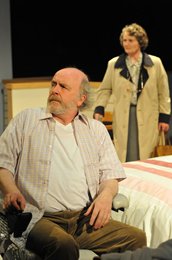Brighton celebrates friendship, hope and the resilience of the human spirit and centres on the characters of Lily, an elderly Irish woman and Fulham supporter who has spent all her working life in England working in the Civil Service, and former actor Jack Dunhill, just turned sixty, who has recently suffered an accident paralysing him from the waist down. The pair meet in the Sisters of Calvary Nursing Home in which works Dave a young care assistant in his twenties. As the story unfolds we witness Lily’s deteriorating health, Jack’s mental recovery, the oscillations of Dave’s love life and the formation of an inspiring and loving friendship between the three. Act One is set in the nursing home while Act Two is set in Brighton General Hospital a few weeks later.
In Brighton, Jim Nolan creates a play that is funny and poignant and in addition to the characters we meet there are others we would like to meet such as Dave’s fickle boyfriend Enzo, the “octogenarian sex-fiend and would be chorister”, Mr Robinson, the sinus afflicted alcoholic priest Fr Mackey and the “impossibly handsome” Fr Fernando. The play is entertaining and the script sparkles with well observed everyday wit and humour, and yet Nolan’s characters must also deal with the realities of witnessing bodies being removed from the nursing home in a black Ford Transit van, the sorrows of childlessness, the pain of coming out as a young gay man, and the bleak realities of permanent paralysis and terminal illness. So, while there is a lighter side to the drama, the play is underpinned by a starkness that eradicates sentimentality.
Designer Joe Vanek uses the sparseness of the institutional settings to reflect these elements within the drama, recreating the reality of such places where furniture, like personal possessions, must be limited and portable. The set is walled on both sides with a colour scheme that is primarily beige and grey, and there is elegance in its simplicity which is warmed in Act One and chilled to a clinical white in Act Two by John Comiskey’s lighting design.
The back wall of the set consists of a large rectangular screen onto which still and moving images are occasionally projected. While the screen adds a sense of space and movement to the stage, bringing the rhythm of clouds drifting across the sky or the slow swaying of daffodils on St. David’s day, it is less effective in dramatising Jack’s interest in horse racing or Lily’s illness which Mark Graham’s unobtrusive sound design effectively conveys providing ample atmosphere and momentum to the drama.
Ben Barnes directs the production with a light touch allowing the humour and wit of the drama to surface while skilfully negotiating the moments when the atmosphere shifts to become more serious, effortlessly orchestrating Nolan’s dialogue with its quick modulations of tone and mood. The cast work well together and the relationships created on stage are fresh, truthful and crucial to the success of this production. Gillian Hannah captures the feisty but limited energy of Lily, Mark Lambert the frustrations and anger of Jack, while Andrew Macklin, playing Dave, embodies just the right amount of youthful exuberance and yet responsibility that his character, as a care assistant, requires. Barnes’ decision to costume the ASMs as clinical staff is dually effective in that it allows the scene changes to be unobtrusively absorbed into the drama and emphasises the realities of hospital life where routine, schedules and support staff are an inescapable aspect of daily life.
The play could be described as an exploration of loyalty: loyalty to one’s team, to one’s lover and to one’s self in a world where the bounce of a ball, the form of a horse, a stumble on an escalator or a malignant tumour can spin one’s life in an opposite direction. The characters within the drama are subject to capricious fate and it is Lily, who faces a most difficult reality, who remains most loyal to the optimism, friendship and humour that define her. Buddah is mentioned in the opening lines of the play and in many ways Jim Nolan has created a little corner of Eastern philosophy in Brighton.
Dr Úna Kealy is a lecturer in the Department of Creative & Performing Arts in Waterford Institute of Technology.